 Website:
Cultured Stone Products
Website:
Cultured Stone Products
Group: BORAL
Catalog excerpts
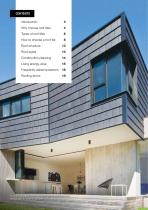
CONTENTS Introduction Why choose roof tiles Types of roof tiles How to choose a roof tile Roof structure Roof styles Construction planning Living energy-wise Frequently asked questions 18 Roofing terms Terracotta: Shingle Eclipse House by Clare Cousins Architects, Photography by Shannon McGrath
Open the catalog to page 2
INTRODUCTION Your home is one of your most important assets. The roof protects and defines your home. It’s also the single largest surface area of a house, making it one of the most important architectural features of the structure. If you’re building your dream home from scratch, extending, renovating or just re-roofing, it’s important to choose carefully. Your roof should be strong and resilient while perfectly complementing your home’s architectural style. This guide is designed to help you make the right choice. It introduces some basic roofing information and takes the guess work out...
Open the catalog to page 3
DESIGN FLEXIBILITY WHY CHOOSE ROOF TILES? Roof tiles offer unsurpassed style, versatility and performance. COLOUR RETENTION ( TERRACOTTA) LONG LASTING LOWMAINTENANCE SALT-SAFE AND FROST-RESISTANT ACOUSTIC PERFORMANCE FIRE RESISTANCE THERMAL PERFORMANCE WIND RESISTANCE Concrete: Vogue Gunmetal RAIN WATER RETENTION
Open the catalog to page 4
The extensive range and unique design of individual tile profiles mean enhanced flexibility in roof design to complement a wide range of architectural styles and specifications. Terracotta and concrete roof tiles each offer a different aesthetic and surface finish. Terracotta tiles are crafted from prepared natural clays that are kiln-fired to temperatures of 1100oC. This means the colour is locked in, so terracotta tiles retain their original appearance as they age. Concrete tiles will weather with age to a matt finish and will lose some colour over time. This colour loss does not affect...
Open the catalog to page 5
TYPES OF ROOF TILES Boral has an extensive range of terracotta and concrete roof tiles manufactured in Australia for Australian conditions and we offer roofing solutions to suit almost any style of home. TERRACOTTA Meaning ‘baked earth’ in Italian, terracotta is a natural clay product that has been used throughout the ages for protection against the elements. Boral terracotta tiles are manufactured using carefully-selected clays that are kiln-fired to temperatures of 1100°C, resulting in a strong yet lightweight roofing material of exceptional quality. The outstanding colour performance is...
Open the catalog to page 6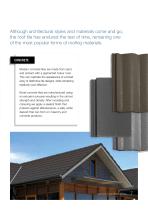
Although architectural styles and materials come and go, the roof tile has endured the test of time, remaining one of the most popular forms of roofing materials. CONCRETE Modern concrete tiles are made from sand and cement with a pigmented colour coat. This can replicate the appearance of a broad array of distinctive tile designs, while remaining relatively cost-effective. Boral concrete tiles are manufactured using an extrusion process resulting in the utmost strength and density. After moulding and colouring we apply a sealant finish that protects against efflorescence, a salty white...
Open the catalog to page 7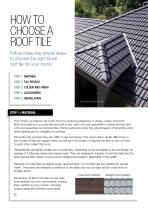
HOW TO CHOOSE A ROOF TILE Follow these five simple steps to choose the right Boral roof tile for your home: STEP 1 MATERIAL STEP 2 TILE PROFILE STEP 3 COLOUR AND FINISH STEP 4 ACCESSORIES STEP 5 INSTALLATION Terracotta: French Eclipse STEP 1: MATERIAL Your choice of material will come down to personal preference in shape, colour and finish. Both terracotta and concrete tiles are built to last, with a 50-year guarantee on terracotta tiles and a 20-year guarantee on concrete tiles. Some customers prefer the natural beauty of terracotta while others appreciate the versatility of concrete....
Open the catalog to page 8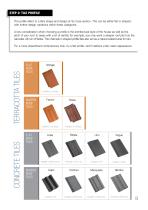
STEP 2: TILE PROFILE The profile refers to a tile’s shape and design at its cross-section. This can be either flat or shaped, with further design variations within these categories. A key consideration when choosing a profile is the architectural style of the house as well as the pitch of your roof. In areas with a lot of rainfall, for example, you may want a steeper roof pitch so the rainwater will run off faster. The channels in shaped profile tiles also act as a natural watercourse for rain. TERRACOTTA TILES For a more streamlined contemporary look, try a flat profile, which delivers a...
Open the catalog to page 9
Terracotta: French Eclipse HOW TO CHOOSE A ROOF TILE STEP 2: CONTINUED This table shows the minimum pitches for each profile & state. MINIMUM ROOF PITCH* (DEGREES) PROFILE MINIMUM PITCH WITHOUT SARKING MINIMUM PITCH WITH SARKING N/A means sarking is mandatory. * Maximum rafter length at the minimum pitch is 4.5 metres.** To be laid in a cross bond on pitches 20o and lower.
Open the catalog to page 10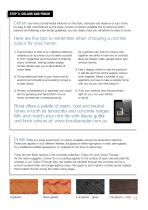
STEP 3: COLOUR AND FINISH Colour can have a fundamental influence on the style, character and essence of your home. It’s easy to feel overwhelmed by the sheer number of options available but by planning well in advance and following a few simple guidelines, you can create a look you will admire for years to come. Here are five tips to remember when choosing a roof tile colour for your home: 1. good place to start is by collecting reference A material such as photos you’ve taken yourself or from magazines and brochures of inspiring colour schemes. Visiting builder display homes will also...
Open the catalog to page 11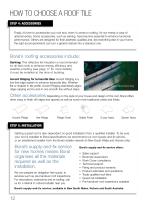
HOW TO CHOOSE A ROOF TILE STEP 4: ACCESSORIES Finally, it’s time to accessorise your roof and, when it comes to roofing, it’s not merely a case of optional extras. Some accessories, such as sarking, have become essential to enhance functional performance. Others are designed for their aesthetic qualities and, like everything else in your home, the right accompaniments can turn a generic feature into a standout one. Boral’s roofing accessories include: Sarking: This reflective foil insulation is recommended for all tiled roofs to enhance energy efficiency and weather-proofing (see page 17...
Open the catalog to page 12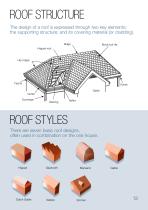
ROOF STRUCTURE The design of a roof is expressed through two key elements: the supporting structure; and its covering material (or cladding). Ridge Boral roof tile Hipped roof Eaves Gable Gutter Downpipe ROOF STYLES There are seven basic roof designs, often used in combination on the one house. Dutch Gable
Open the catalog to page 13All Cultured Stone Products catalogs and technical brochures
-
BORAL BRICKS - NSW & ACT
28 Pages
-
SA BRICK AND BLOCK
6 Pages
-
BORAL ASPHALT COMPANY PROFILE
20 Pages





